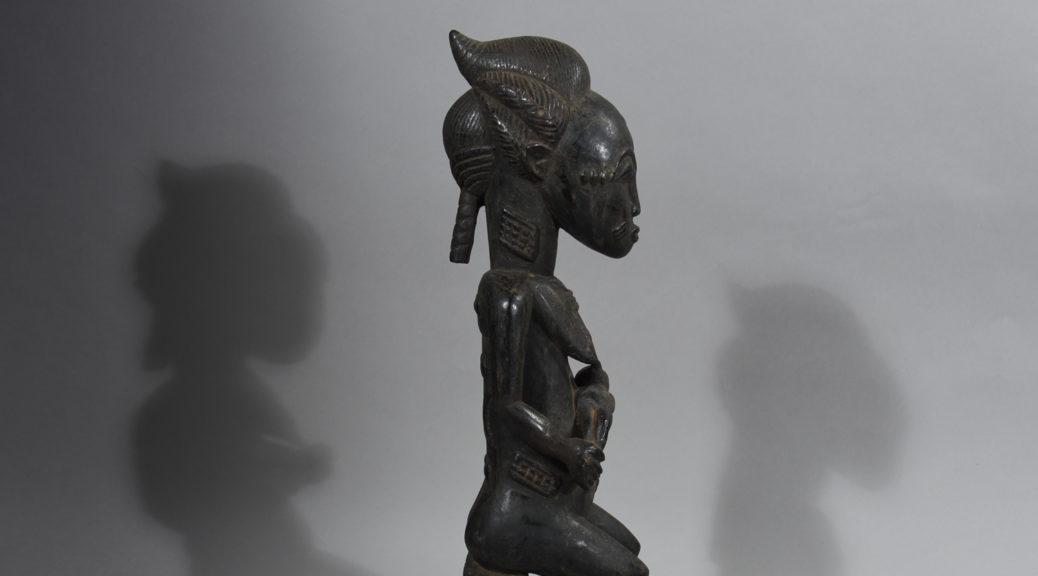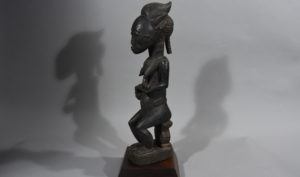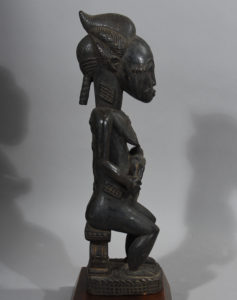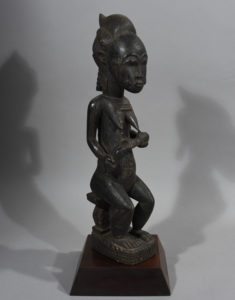ACK 0619-3
Baoulé Maternity figurine, Côte d’Ivoire
A magnificent and very beautiful, blue colored maternity figurine of the ‘asie usu or blolo bla’ type is of the Baoulé tribe which are part of an Akan people established in the Centre of Ivory Coast, in West Africa.
This beautiful shiny blueish patina with voluminous fine grooved coiffure, raised scarification marks holding a breastfeeding baby, representing the very ideal of female perfection in Baule culture, and this figure was probably carved as a wife from the other world. The fine scarification and well-tressed hair are marks of her beauty and made for a spirit husband, Blolo bian. According to Vogel, ‘these figures represent an ideal of womanhood, embodying not only physical perfection, but social, moral and intellectual achievement. Spirit spouse sculptures can be seen as a kind of opposite sex alter ego and are a fascinating case of the use of art in Africa for individual psychological relief. The Baule are one of a number of African groups who believe that before birth, human beings all had Blolo bla (spirit wife) and Blolo bian (spirit husband) spouses in the other world who can influence their lives. Baule artists and their nearby neighbors seem to be the only artists in Africa who traditionally carved figural representations of spirit spouses.
The more elaborate the ornamental and decorative features of an individual work, the more time has been invested in its execution by the sculptor, and the greater the expense to its owner. The culmination of such efforts hopefully results in the creation of a sculpture that is most attractive to the asye usu. When used by Baule diviners, such works not only flatter the asye usu but also add to the theatrical spectacle of a public pronouncement of a divinatory revelation. Their aesthetic quality dazzles potential clients with the caliber and sophistication of the instruments associated with a diviner.
The beauty of a figure advertises its owner’s success as an intermediary with the spirit world. Consequently, diviners prosper by commissioning superlative figures as divinatory instruments. Ownership of extraordinary objects thus directly affects a diviner’s professional standing and enhances public perception of his or her efficacy. (Sources: A History of Art in Africa / Africa – The Art of a Continent).
The Baule create art in several media, including wooden sculpture, gold and brass casting similar their Asante ancestors, and mask and figure carving, which have been greatly influenced by their Senufo and Guro neighbors.
Age: Mid-20th century.
Measure: H: 42, W: 10, D: 11 cm. – Weight: 955 grams
Condition: Despite age this figure is in an excellent condition. No cracks or insect bites.
Provenience: German private collection. Bought on Dutch auction.
Literature: “For Spirits and Kings: African Art from the Paul and Ruth Tishman Collection”,
Edited by Susan Mullin Vogel




